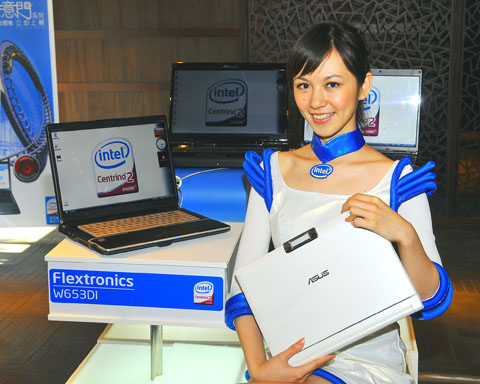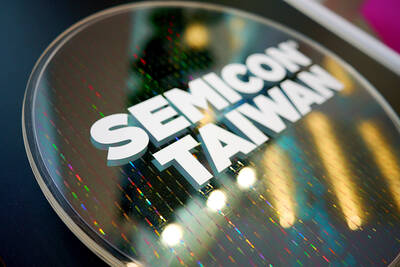Chip giant Intel Corp yesterday unveiled its next-generation mobile chip, promising lower power consumption, faster processing speed and high-definition video performance to boost growth in the expanding laptop computer market.
After several months delay, Intel launched the Centrino 2 — previously code-named Montevina — around the globe yesterday.
“What we are talking about is 302 million-unit [notebook] market. This is a huge opportunity. Notebooks will be a factor driving future growth,” Stanley Huang (黃逸松), the director of Intel’s Asia-Pacific region, told a press briefing in Taipei.

PHOTO: LI CHIU-MING, TAIPEI TIMES
OVERTAKE
Sales of notebook computers could overtake desktop computers to account for 60 percent of the personal-computer (PC) market by 2011, Huang said, citing International Data Corp (IDC) estimates.
Desktop computers are expected to still account for more than 50 percent of the PC market this year based on IDC’s forecast, he said.
With their low power consumption, the new Centrino 2 chips can save up to 25 percent on battery life compared with Intel’s Santa Rosa chips, allowing users to watch a full Blu-ray DVD movie on their laptops with one battery charge.
The Centrino 2 chip also raises wireless connectivity to 450 megabytes per second with optimal WiMAX connection.
Fifteen notebook PC makers, including Hewlett-Packard Inc, Acer Inc and Lenovo Group (聯想) showcased their latest laptops powered by Centrino 2 chips during the Intel launch.
“We believe the sale of Intel’s new platform will usher in a new wave of growth for PCs, especially notebooks, as consumers will benefit more from Intel’s new platform, which offers longer battery life and better performance,” said Ken Wong (黃建恒), Lenovo’s general manager in Taiwan and Hong Kong.
SUSTAINABLE
Wang also said that the growth momentum of notebook computers in Taiwan would be sustainable in the second half, despite fears that mounting inflation could hurt PC demand.
Lenovo said it planned to launch five models outfitted with Centrino 2 in the second half, some of which would be available for sales in Taiwan by the end of this month.
Commenting on the uptake of Intel’s new chip, IDC analyst Dickie Chang (張祐昌) said: “It is nice to have a strong-performance laptop with Centrino 2, but people should think twice before making an order as high-definition content remains limited.”
Chang said consumer taste was also shifting, with buyers putting more emphasis on the exterior design rather than simply the performance of a computer.
“Technology upgrade used to spur new PC demand, but the impact is diminishing,” Chang said.

With this year’s Semicon Taiwan trade show set to kick off on Wednesday, market attention has turned to the mass production of advanced packaging technologies and capacity expansion in Taiwan and the US. With traditional scaling reaching physical limits, heterogeneous integration and packaging technologies have emerged as key solutions. Surging demand for artificial intelligence (AI), high-performance computing (HPC) and high-bandwidth memory (HBM) chips has put technologies such as chip-on-wafer-on-substrate (CoWoS), integrated fan-out (InFO), system on integrated chips (SoIC), 3D IC and fan-out panel-level packaging (FOPLP) at the center of semiconductor innovation, making them a major focus at this year’s trade show, according

DEBUT: The trade show is to feature 17 national pavilions, a new high for the event, including from Canada, Costa Rica, Lithuania, Sweden and Vietnam for the first time The Semicon Taiwan trade show, which opens on Wednesday, is expected to see a new high in the number of exhibitors and visitors from around the world, said its organizer, SEMI, which has described the annual event as the “Olympics of the semiconductor industry.” SEMI, which represents companies in the electronics manufacturing and design supply chain, and touts the annual exhibition as the most influential semiconductor trade show in the world, said more than 1,200 enterprises from 56 countries are to showcase their innovations across more than 4,100 booths, and that the event could attract 100,000 visitors. This year’s event features 17

EXPORT GROWTH: The AI boom has shortened chip cycles to just one year, putting pressure on chipmakers to accelerate development and expand packaging capacity Developing a localized supply chain for advanced packaging equipment is critical for keeping pace with customers’ increasingly shrinking time-to-market cycles for new artificial intelligence (AI) chips, Taiwan Semiconductor Manufacturing Co (TSMC, 台積電) said yesterday. Spurred on by the AI revolution, customers are accelerating product upgrades to nearly every year, compared with the two to three-year development cadence in the past, TSMC vice president of advanced packaging technology and service Jun He (何軍) said at a 3D IC Global Summit organized by SEMI in Taipei. These shortened cycles put heavy pressure on chipmakers, as the entire process — from chip design to mass

SEMICONDUCTOR SERVICES: A company executive said that Taiwanese firms must think about how to participate in global supply chains and lift their competitiveness Taiwan Semiconductor Manufacturing Co (TSMC, 台積電) yesterday said it expects to launch its first multifunctional service center in Pingtung County in the middle of 2027, in a bid to foster a resilient high-tech facility construction ecosystem. TSMC broached the idea of creating a center two or three years ago when it started building new manufacturing capacity in the US and Japan, the company said. The center, dubbed an “ecosystem park,” would assist local manufacturing facility construction partners to upgrade their capabilities and secure more deals from other global chipmakers such as Intel Corp, Micron Technology Inc and Infineon Technologies AG, TSMC said. It